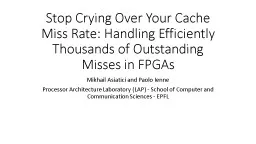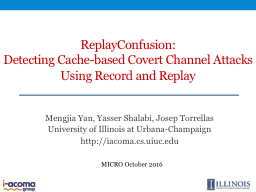PPT-Stop Crying Over Your Cache Miss Rate:
Author : mitsue-stanley | Published Date : 2019-12-21
Stop Crying Over Your Cache Miss Rate Handling Efficiently Thousands of Outstanding Misses in FPGAs Mikhail Asiatici and Paolo Ienne Processor Architecture Laboratory
Presentation Embed Code
Download Presentation
Download Presentation The PPT/PDF document "Stop Crying Over Your Cache Miss Rate:" is the property of its rightful owner. Permission is granted to download and print the materials on this website for personal, non-commercial use only, and to display it on your personal computer provided you do not modify the materials and that you retain all copyright notices contained in the materials. By downloading content from our website, you accept the terms of this agreement.
Stop Crying Over Your Cache Miss Rate:: Transcript
Download Rules Of Document
"Stop Crying Over Your Cache Miss Rate:"The content belongs to its owner. You may download and print it for personal use, without modification, and keep all copyright notices. By downloading, you agree to these terms.
Related Documents














